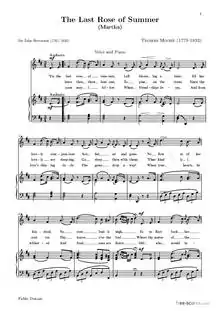夏天的最后一朵玫瑰
《夏天的最后一朵玫瑰》(The Last Rose of Summer),或译夏天里最后一朵玫瑰,是爱尔兰诗人托马斯·摩尔创作的一首诗。1805年,诗人在爱尔兰基尔肯尼郡的詹金斯顿城堡(Jenkinstown Castle)中创作了这首诗,并在1813年出版。这首诗可以以爱尔兰传统曲调《年轻人的梦》(Aisling an Óigfhear)演唱[1],这个曲调本身则是爱尔兰民歌搜集家爱德华·邦廷1792年在贝尔法斯特竖琴音乐节上记录下来的[2]。它在后世被贝多芬等音乐家广泛采用[3]。

词

'Tis the last rose of summer,
Left blooming alone;
All her lovely companions
Are faded and gone;
No flower of her kindred,
No rose-bud is nigh,
To reflect back her blushes
Or give sigh for sigh!
I'll not leave thee, thou lone one.
To pine on the stem;
Since the lovely are sleeping,
Go, sleep thou with them;
Thus kindly I scatter
Thy leaves o'er the bed,
Where thy mates of the garden
Lie scentless and dead.
So soon may I follow,
When friendships decay,
And from love's shining circle
The gems drop away!
When true hearts lie withered,
And fond ones are flown,
Oh! who would inhabit
This bleak world alone?[4]
参考文献
- Walton's, editors. . 1993.
- Edward Bunting, A General Collection of the Ancient Irish Music (1796)
- Axel Klein: "'All her lovely companions are faded and gone' – How The Last Rose of Summer Became Europe's Favourite Irish Melody" and its appendix, "Utilisations of 'The Last Rose of Summer', respectively 'The Groves of Blarney', by European Composers in the Nineteenth Century, in Chronological Order", in: Sarah McCleave & Brian Caraher (eds.): Thomas Moore and Romantic Inspiration. Poetry, Music, and Politics (London: Routledge, 2018), pp. 128–145 & 231–253; ISBN 9781138281479 (hardback), ISBN 9781315271132 (e-book).
- Moore, Thomas; Stevenson, John. . Number V. London: J. Power. 1813: 16.
- "The Last Rose of Summer", The Moving Picture World (New York City), 5 October 1912. p. 14. Internet Archive, San Francisco. Retrieved 3 October 2021.
- Kenton Bamford, Distorted images: British national identity and film in the 1920s (1999), p. 8
- . Deanna Durbin Devotees. [9 July 2013]. (原始内容存档于2019-08-12).